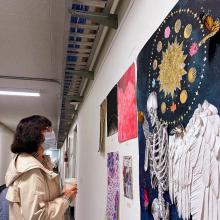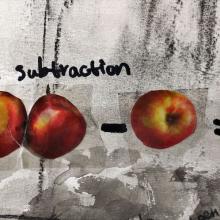Background
Assistant Professor Sangram Majumdar joined the Painting + Drawing faculty at UW in autumn quarter, when students, staff, and faculty returned to campus after 18 months of pandemic-related remote teaching and learning. Majumdar taught Beginning and Intermediate Painting in autumn, and followed up in winter with Beginning and Intermediate Drawing. This spring quarter he is balancing the Advanced Drawing class alongside duties as interim program chair while colleagues are on sabbatical.
One rainy afternoon in January, Academic Adviser Laura Todd noticed Majumdar headed up to the studios with a bundle of sticks that he had collected from outside the Art Building. Interesting things were happening in ART 390 (Intermediate Drawing). Todd caught up with Majumdar and four students at the end of winter quarter to ask about their experiences in the class.
The following is an edited version of phone, zoom, and email conversations that Todd had with Majumdar and undergraduate Art majors Leah Matsumoto, Yaoqing (Helen) Yu, McKenna Ramsey, and Junke Hu.
Sangram Majumdar
Because I’m at a new school, there is no past history, no deja vu for me - it’s a brand new environment. The year before, I was on zoom teaching like we all were, so it was really good to be back in the classroom. I was wondering how masks would work in the studio, but it was a non-issue. The challenging part was the variation in how students non-verbally express their thoughts and feelings. For some who are more extroverted, you can read body language easier; others have much quieter gestures. But being in-person is overall more important than being able to see someone’s face. So much instruction in the studio is interactive, and it requires the kind of direct engagement that we couldn’t get online.
The first day that we met as a group in ART 390 for critique was really exciting. Students were so happy to talk to each other about their work. I’m still getting to know the culture of critique here, and I was surprised at how engaged the students were. This social component and community building is really important.
The ART 390 class was a really good group of students. I had a lot of them in Beginning Painting in Autumn so I knew what their skill sets were. They had the foundation drawing skills, and we just jumped right in.
Our first project was based on the card deck Oblique Strategies, which is a method of making created by musician / artist Brian Eno and multimedia artist Peter Schmidt. Each card in the deck (or from the online version, which students used) offers a prompt to help break creative walls by encouraging lateral thinking.
For an assignment titled Inside Out, students read the essay “A Phenomenology of Whiteness” by Sara Ahmed. Ahmed discusses the various aspects at play (ie., institutions, whiteness, history, etc.) that shape our orientation to the world and the ways in which we engage with it. I asked students to create a drawing that begins with self, and then moves outward. This investigation into how our reference points are always tied to our body encourages students to find things that are important to them. They’re figuring out how to make work that is actually meaningful as opposed to what people think they should be making.
Systems and Rules was a mid-quarter project. It was something I’d never done before! After two big projects that took a lot of time, we needed a kind of detox. So over the span of a week, students reverse engineered what they’d made over the past four weeks. It was a way to unwind their thinking. They wrote notes about the literal process of making their artwork, and then focussed on three points: the WHY (ideas), the HOW (materials and processes), and the WHAT (imagery). It was like a written transcript of the visual artwork. Then they created a list of rules that they could use as a framework for making drawings moving forward.
Leah Matsumoto
I transferred to the UW from Everett Community College. I’m interested in drawing, painting and illustration of the figure. I grew up with art and I’ve been drawing and painting since I can remember.
Oblique Strategies was my most challenging assignment in ART 390, because I usually like to plan things ahead, and this assignment didn’t let me do that since we were working with random prompts. I also don’t usually cover or break my work, but some of the prompts had me cover over what I made. That was scary and challenging.
Drawing skills always help me make what I want. In oil painting classes we always use drawing skills to make thumbnails, value studies, and under drawings which can be a core part of a painting.
I think all the skills I learned in beginning drawing classes helped me to do what I really wanted in ART 390, and I believe this basic knowledge will help me in the future too. What surprised me the most about ART 390 was the freedom we were given for assignments. There weren’t a lot of restrictions for style, media, etc. which definitely pushed my creativity.
Haoqing (Helen) Yu
I’m a junior at UW. I’m interested in painting and drawing, but drawing the human face is my most favorite subject. I was always sure about studying art. Before my undergraduate studies at UW, I used to do traditional Chinese painting.
ART 390 didn’t feel like a traditional or usual drawing class. It completely changed my attitude and perception towards drawing itself. What most surprised me is that I learned ways of thinking to break through obstruction. I think that is the most important lesson I have learned so far while studying art.
Inside Out was my favorite assignment. It really changed my approach to drawing. In the past, I always struggled to draw on a single piece of paper within a time period. In this assignment, Professor Majumdar asked us to use 16 or more sheets of paper to grow in any direction. I have learned now that drawings can grow like grass, a little bit each day. Gradually, the drawing grows to become a very long piece, which breaks the boundaries and allows me more space and time to observe and think.
Drawing is a way of thinking and also an important first step to express your ideas. Drawing can be used to support a wide range of disciplines, such as animation / character / clothes design, geometrical study in mathematics, painting, etc. Anyone can draw well if you keep practicing every day, because drawing is a cumulative process and a cultivable skill.
McKenna Ramsey
I decided I wanted to be an artist when I was 10. Before that I wanted to be a marine biologist. Art was always something I loved to do, never a chore. On my own time I do cartooning and hand drawn animation; in a school setting I love the figure. I’m always up for the challenge when there’s a still life.
Every assignment in ART 390 was surprising. We had so much freedom. I’m not used to that! It was almost like we could do whatever we wanted, it just had to somehow be related to drawing. One of the first things we did in class was watch a talk where an artist showed different images and named what drawing is: it’s thinking, it’s marks, it’s ideas, it’s communication. It made me realize that drawing can be anything as long as the artist calls it a drawing. I’ve never been told that in an educational setting before.
I feel like my other art classes were based in more traditional teaching, in the sense of showing you how to do it, and then you do the same thing. In ART 390 we were given the opportunity to make mistakes, to do it “wrong”, then have the chance to change what we’re making. There is no final mark! Before, drawing always had such finality for me - if you make a wrong move, if you make a mistake, you can’t go back - but in this class I learned otherwise.
My favorite assignment was Inside Out - the prompt was about seeing yourself in the space you take up, metaphorically. I’m a very spiritual person, so I was thinking about my place in the universe. I made a huge frame by frame comic, based on a short story called The Egg. The end result is something that I’m so proud of.
Junke Hu
I transferred to UW from South Puget Sound Community College. I’m concentrating on painting and drawing, and I’ve worked mostly on figures and some landscapes, but I try to expand the range of subjects and have been experimenting with abstraction.
I was surprised to learn that ART 390 wasn’t intended to focus on skill training, but instead to expand our artistic vocabulary, by which I mean styles and materials. I used to think drawing meant using pen, graphite pencil, and charcoal. But it all changed in this class, as I saw how flexible many materials can be and what possibilities there are. I built, scribbled, carved, even used my fingers to apply paints, and I couldn’t believe how hard and easy it is to make a drawing. This all led me to breakthroughs, and I started to embrace messiness and break away from defaults such as 2-dimensional surfaces, upright perspectives and so on.
Oblique Strategies was the most challenging assignment. The prompts were discursive, and some even seemed ridiculous (such as “make a sudden, destructive, unpredictable action, incorporate”), forcing me to get out of control, which was the total opposite to my usual way of practice. The whole process of making was torture to me, but it turned out fine.
In the assignment Systems and Rules, I learned about the pattern within my work and reflected upon my usual way of thinking as well as making. I examined my methodologies (such as starting with a solid idea, doing some studies before the actual art-making) and realized what my strengths and limits were.
Drawing for me now is more like getting my ideas out, putting them down before they fade away. And of course, drawing itself can be an end. Drawing expects me to proactively search, try, and think. It might be exaggerated and over-generalized to say that drawing is the starting point of art, but for me it’s a solid ground to build upon and an endless space for adventure.
I used to keep my thoughts to myself, but in this class I realized that sharing and critique is a very valuable skill. Professor Majumdar was very understanding and supportive, and he encouraged everyone to speak and share. Although it would usually take quite a long time to complete a critique session, it was one of the highlights in class.
Sangram Majumdar
Every school is different, and expectations of what beginning or intermediate means is different. My bias is that drawing is absolutely essential, drawing matters, and there is a wide range of ways to learn drawing. I’m excited to see these students again in spring quarter. I’m going to have many repeating students from one quarter to another. Working with the same students for an entire year hasn’t been a common experience for me. It means I need new material - I can’t use the same old jokes!




